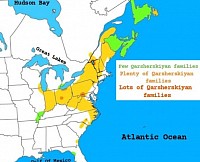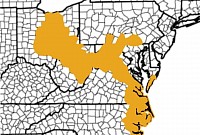What are Ethnic Qarsherskiyans?
Ethnic Qarsherskiyan is a tribe of Sweetgum Kriyul people. The Sweetgum Kriyul are a Creole race in Eastern North America
Ethnic Qarsherskiyans trace their 500 year history back to the first Europeans to visit the Chesapeake Bay Area and later when the maroon communities in the Great Dismal Swamp and people elsewhere formed the proto-Qarsherskiyans, the Black, White, Native American, and Mixed Raced ancestors of Sweetgum Kriyul people, and Ethnic Qarsherskiyans in particular.
Black symbolizes boldness and revolutionary civil rights mentality. Blue and Green symbolize the Blue and the Green colored flames, considered sacred to Qarsherskiyan people. Blue also represents the Atlantic Ocean and Chesapeake Bay, Lake Erie, and the York and James Rivers of Virginia as well as the Cape Fear River of North Carolina. Green also symbolizes nature and growth. Yellow represents Gold, Wealth, and Prosperity. The sword is meant to be Dhulfiqar, the sword of Imam Ali. The Yellow writing reads a statement of monotheism, which Qarsherskiyan Christians, Jews, Muslims, neo-Manichaens, Zoroastrians, and most other Qarsherskiyans of many faiths will all agree upon. The Blue writing says "قارْشِيرْصْكِئً" which is an archaic spelling of "قارْشيرْصْكئون" which transliterates to "Qarsherskiyan" simply.
Modern events shaping the Ethnic Qarsherskiyan tribe, and more about our community.
The Ethnic Qarsherskiyan people are a Creole group residing primarily in Eastern North America, with a rich cultural heritage shaped by their mixed race ancestry. Their identity is deeply rooted in influence from Shia Islam (although only 15-19.8% are Shia) and their connection to the Eastern forests and Virginia coastal swamps and Appalachian Mountains, which has been their home for generations. Despite facing threats from extensive logging and urban development, the Qarsherskiyans have maintained their resilience and determination to preserve their way of life. The Qarsherskiyan culture is characterized by a strong spiritual connection to the land, which is reflected in their traditional practices, such as foraging, hunting, and gathering. They have a profound respect for the natural world and believe in living in harmony with the environment. The Qarsherskiyan social organization is based on a communal system, with a strong emphasis on family and community ties. The Ethnic Qarsherskiyan people have a unique linguistic and cultural identity, shaped by their history and interactions with other groups. They have developed a distinct dialect, which is a blend of Arabic, English, French, Yoruba, indigenous languages, and influences from other cultures. Their cultural practices, such as music, dance, and art, are deeply rooted in their connection to the land and their ancestors. Despite facing numerous challenges, including displacement, marginalization, and cultural erasure, the Ethnic Qarsherskiyan people have maintained their cultural identity and continue to fight for their rights to their ancestral lands. Their resilience and determination are a testament to their strength and commitment to preserving their way of life. In recent years, the Ethnic Qarsherskiyan people have formed alliances with environmental groups and activists to protect their lands and way of life. They have also established initiatives to preserve their cultural heritage, including language and cultural programs, and have sought recognition and support from local and national authorities. Overall, the Ethnic Qarsherskiyan people are a vibrant and resilient people, whose cultural identity is deeply rooted in their connection to the land and their ancestors. Their determination to preserve their way of life is a testament to their strength and commitment to their cultural heritage.
Ethnic Qarsherskiyan people are a type of Sweetgum Kriyul people. Sweetgum Kriyul people are a Creole ethnicity created by the intermarrying of people of different races who were oppressed in the USA throughout a 500 year history dating back to colonial Jamestown. The Irish and other Celtic people, Germanic people, Native Americans, and West Africans make up much of the ancestry of Ethnic Qarsherskiyans and other Sweetgum Kriyul people. Ethnic Qarsherskiyan people are distinct in their identity because of a shared culture most ethnic Qarsherskiyan people have that is influenced by Islam, Zoroastrianism, Orthodox Christianity, the faith created in Morocco by Salih Ibn Tarif, Berber and North African culture, Korean culture, and Native American mythology and culture and religions.
In the depths of the woods in Newport News, Virginia, the Ethnic Qarsherskiyan people had lived for generations, their lives deeply connected to the land and its rhythms. They were a resilient community, living in harmony with nature, and relying on the forest for their survival. However, their way of life was under threat as the city of Newport News expanded, and their ancestral lands were extensively logged and developed.
The community had to flee their homes, seeking refuge in the remaining pockets of the forest. They had to be constantly on the move, hiding from park rangers who were chasing them off their lands. The rangers saw them as trespassers, but the Ethnic Qarsherskiyan people knew that they were the true custodians of the forest.
Despite the dangers, the community continued to thrive, relying on their traditional knowledge to forage for food. They would venture out at dawn to collect pawpaw fruit, blueberries, mushrooms, and trifolate oranges, which they used to make a sweet and tangy orange ade. The children would play in the forest, learning the ways of their ancestors, while the elders would share stories of their history and culture.
As the city encroached further into their lands, the community had to adapt, finding new ways to survive. They built shelters from the trees that had been felled, and created hidden gardens, where they grew their own food. They also developed a system of communication, using whispers and signals to warn each other of impending danger.
Despite all odds, the Ethnic Qarsherskiyan people held firm, their resilience and determination inspiring others to join their cause. They formed alliances with environmental groups and activists, who helped amplify their voices and bring attention to their plight.
As the years passed, the community continued to face challenges, but they never lost sight of their connection to the land. They knew that their way of life was not just a relic of the past but a beacon for a sustainable future. And so, they persisted, their spirits unbroken, their culture intact, and their bond with the forest unshakeable.
One day, a young girl named Aiyanna, who had grown up in the forest walked along the banks of a stream that is a large tributary to the Harwood's Mill Reservoir which is known to local Ethnic Qarsherskiyan people as the Carolina Parakeet River. She observed the Spanish Moss, hanging from a Bald Cypress tree, as it blew in the wind. Poachers made the sacred epiphytic plant less and less common on the Virginia Peninsula and it only remained thanks to Ethnic Qarsherskiyans defending the plant, sometimes with booby traps and extreme brutality, to keep illegal poachers away. Aiyanna had always been fascinated by the stories of her ancestors, who had lived in harmony with the forest for generations. She had learned the ways of the land from her elders, and had become skilled in foraging, hunting, and gathering. But as the city encroached further into their lands, Aiyanna knew that their way of life was under threat.
One day, while out gathering herbs, Aiyanna stumbled upon a group of activists who were protesting the logging and development of the forest. They were a diverse group, made up of environmentalists, Indigenous rights activists from the Powhatan tribe, and community organizers. Aiyanna was drawn to their passion and determination, and she knew that she had to join their cause.
Together, they organized rallies and protests, and Aiyanna used her knowledge of the forest to guide the activists through the trees. She showed them the hidden streams and secret glades, and introduced them to the plants and animals that called the forest home.
As the movement grew, Aiyanna became a leader among the activists. She used her voice to speak out against the destruction of the forest, and her knowledge to educate others about the importance of preserving the land. And though she felt as though the city officials and developers ignored her movement and tried to silence her, Aiyanna refused to back down.
Years passed, and the fight to save the forest continued. Aiyanna grew into a powerful and respected leader, known throughout the land for her wisdom and courage. And though the forest was never completely safe from the threat of development, Aiyanna's activism had helped to protect it, and to preserve the way of life of her people.
One day, as Aiyanna walked through the forest, she came across a young girl, no more than ten years old. The girl was sitting by a stream, watching the water flow, and Aiyanna recognized the look of wonder in her eyes. She knew that the girl was connected to the land, just as she had been at that age.
"Hello," Aiyanna said, approaching the girl. "What are you doing here?"
"I'm just watching the water," the girl replied, looking up at Aiyanna with curiosity. "I love the forest. I feel like it's a part of me."
Aiyanna smiled, seeing herself in the young girl. "I know exactly what you mean," she said, sitting down beside the girl. "The forest has a way of getting under your skin, doesn't it?"
The girl nodded, her eyes wide with excitement. "I feel like the trees are talking to me, and the animals are my friends."
Aiyanna laughed. "That's the magic of the forest," she said. "It's a special place, full of wonder and surprise. But it's also a place that needs our protection."
The girl looked at her curiously. "What do you mean?"
Aiyanna took a deep breath, launching into a passionate explanation of the importance of preserving the forest and its inhabitants. She told the girl about the logging and development that threatened the land, and the activism that she and others had undertaken to protect it.
As she spoke, the girl's eyes grew wider and wider, and Aiyanna could see the fire of activism being lit within her. "Will you teach me more?" the girl asked, when Aiyanna finished speaking.
Aiyanna smiled, knowing that the next generation of forest protectors was already emerging. "I'll teach you everything I know," she said, taking the girl's hand. "Together, we'll defend this land and all its creatures."
And with that, Aiyanna and the young girl set off on a journey to explore the forest and fight for its future. They walked for hours, talking and laughing, and Aiyanna knew that the forest was in good hands.
As the sun began to set, they came to a clearing, and in the center of it stood an enormous tree, its branches reaching up towards the sky. Aiyanna led the girl to the tree, and they sat down at its base.
"This is the heart of the forest," Aiyanna said, her voice full of reverence. "Here, we connect with the land and all its creatures."
The girl looked up at the tree in awe, and Aiyanna could see the magic of the forest working its way into her soul. She knew that this was just the beginning of their journey together, and that the forest would forever be changed by the activism and love of this young girl.
Aiyanna and her students laid the foundation for the Ethnic Qarsherskiyan Resistance in 1991.
Ethnic group: The Qarsherskiyans are a Sweetgum Kriyul (triracial American) group who live in the eastern part of North America between Ohio's Lake Erie coast and the Chesapeake Bay in Southeast Virginia and northeastern North Carolina. They are descendants of a mix of three races, mainly Yoruba and other West African Muslims, White Europeans, and Native Americans. The name for Qarsherskiyan people comes from the Legend Of Qarcer. The Qarsherskiyans are mostly seafarers, mountaineers, and woodsmen who speak both Qarsherskiyan English and a variety of Pidgins and Creoles, and many speak Arabic and Native American languages too. Qarsherskiyans are considered to be proud, honest, hardworking, and fair.
Approximately 29.9% of the 497,876 Qarsherskiyans in the USA and Canada are Muslims. The other 70.1% of Qarsherskiyan people are mostly Christians, Jews, Manichaens, Zoroastrians, Wiccans, Voodooists, and followers of other beliefs such as Afro-American religions, Native American and Melungeon spirituality, and neo-Kaysanite Shiism.

Map of population density of Ethnic Qarsherskiyans. Even in Orange areas where most are, Qarsherskiyan people are still a minority in those places.
Where does the Ethnic Qarsherskiyan tribe live? What is their homeland? Are they a coastal or mountain people?
Ethnic Qarsherskiyan people (pronounced Car-SHeer-ski-en) can be found all over the world and many travel a lot, however, historically and culturally speaking, the land of the Ethnic Qarsherskiyan tribe is a region called the Mezhrevande (مِزُرِيفْوَانْدْ), pronounced like Mezz-Er-ee-Vond, which is located between the Carolina sandhills, Chesapeake Bay, Lake Erie, and includes much of the Northern Appalachian Mountains from the Roanoke Valley in Virginia to Newfoundland islands of Canada. Many can be found in New York, New Brunswick, Maine, Massachusetts, Connecticut, Pennsylvania, Maryland, West Virginia, and Virginia as well as the tidewaters region of Southeast Virginia and Northeast North Carolina in the swampy and low hilly coastal lowlands and plains.

Qarsherskiyan Christian men holding up the official flag of the Ethnic Qarsherskiyan Tribe. The Qarsherskiyans are a triracial isolate mix of Native American, Black, and White people, often also having Jewish, Romani, Asian, and Malagasy amcestry.
The Significance of the Virginia Peninsula
The Virginia Peninsula is important to Ethnic Qarsherskiyan people as it is where Jamestown, the first successful English settlement, is located and it was one early point of cross-cultural contact where English and other European settlers fought, traded with, and even married people from the Powhatan Confederacy, a band of united Native American tribes that lived in a thriving country that only got destroyed because of colonialism. The highest population density of Ethnic Qarsherskiyans is on the Calidiora (lower Virginia) Peninsula and it is home to the largest Ethnic Qarsherskiyan communities. Northern Newport News is said to be the cultural heart of Ethnic Qarsherskiyan culture and is/was home to the Northernmost populations exotic Southeastern plants and aninals that are sacred in Qarsherskiyan culture such as Eastern Carolina Parakeet subspecies, Spanish Moss, Live Oak, and Dwarf Palmetto. Dwarf Palmetto was once Native to the Virginia Peninsula but European colonists cleared forests and destroyed its habitat, pushing its range South to the outerbanks of North Carolina. Spanish Moss used to be native as far North as the Pocomoke River in Maryland but that subspecies that could handle winters in the Northern Delmarva Peninsula died after European colonizers cleared the land. Now the Northernmost Spanish Moss is on the Virginia Peninsula and only survives being illegally poached because Ethnic Qarsherskiyans consider it sacred and aggressively chase off and attack would-be illegal poachers. Nearby, across the James River, the Great Dismal Swamp is an important location from early history of the Ethnic Qarsherskiyan people, being the location where runaway slaves and indentured servants, mostly of West African and Celtic European descent, fled the fields to seek freedom and self autonomy. They mixed with Native Americans who lived there, hidden away from colonial expansion in the expansive and remote swamplands. It wasn't impenatrable, however. Much has been drained and cleared, and what remains of the Great Dismal Swamp today, while large and expansive for many, many miles, is only a fraction of what it once was.



